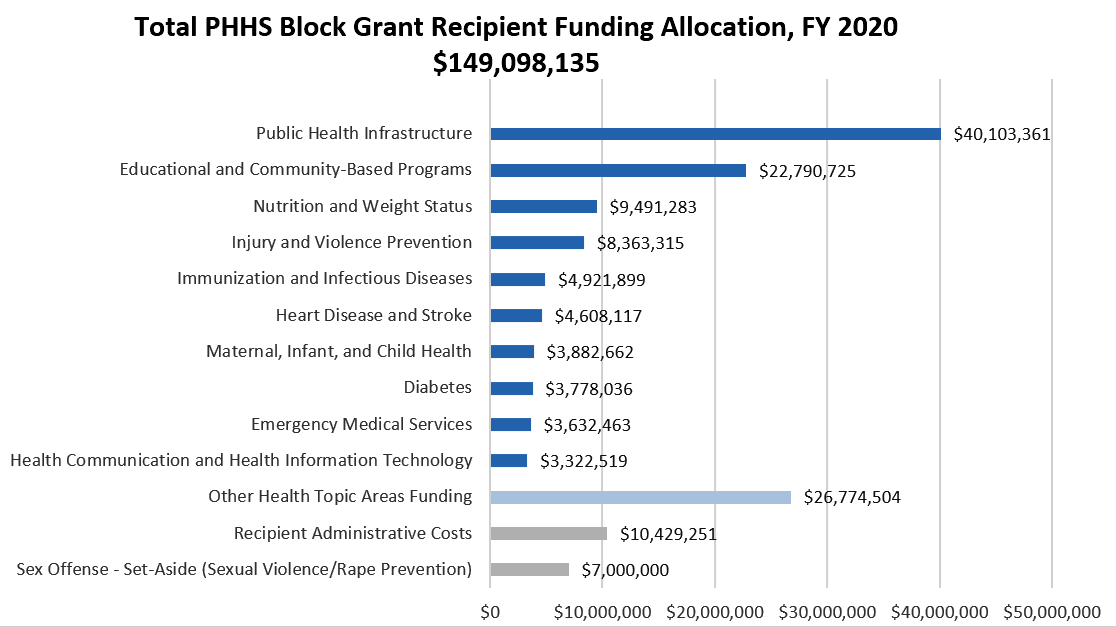At a glance
This funding page provides details on the top funded health topic areas allocated by recipients based on their priority public health needs. Currently, these data are only available for FY2020.
Funding Overview
For Fiscal Year 2020, PHHS Block Grant recipients received a total of $149,098,135 in funding. Of this funding, $131,668,884 is allocated by recipients to health topic areas based on their priority public health needs. In addition, Congress legislatively mandated $7,000,000 for sexual violence/rape prevention activities. The remaining amount, $10,429,251, is used for recipient administrative costs.
Highlights
The following table and bar chart provide details on the top funded health topic areas.†

| Funding Category | FY 2020 Amount | % of TRAHTAF1 | % of TRF2 |
|---|---|---|---|
| Recipient-Allocated Health Topic Area (HTA) | |||
| Public Health Infrastructure | $40,103,361 | 30.5% | 26.9% |
| Educational and Community-Based Programs | $22,790,725 | 17.3% | 15.3% |
| Nutrition and Weight Status | $9,491,283 | 7.2% | 6.4% |
| Injury and Violence Prevention | $8,363,315 | 6.4% | 5.6% |
| Immunization and Infectious Diseases | $4,921,899 | 3.7% | 3.3% |
| Heart Disease and Stroke | $4,608,117 | 3.5% | 3.1% |
| Maternal, Infant, and Child Health | $3,882,662 | 2.9% | 2.6% |
| Diabetes | $3,778,036 | 2.9% | 2.5% |
| Emergency Medical Services | $3,632,463 | 2.8% | 2.4% |
| Health Communication and Health Information Technology | $3,322,519 | 2.5% | 2.2% |
| Total Top 10 HTA Funding | $104,894,380 | 79.7% | 70.4% |
| Total Other HTA Funding | $26,774,504 | 20.3% | 18.0% |
| Total Recipient-Allocated HTA Funding (TRAHTAF) | $131,668,884 | 100.0% | 88.3% |
| Sex Offense Set Aside (Sexual Violence/Rape Prevention)* | $7,000,000 | 4.8% | |
| Recipient Administrative Costs | $10,429,251 | 7.0% | |
| Total Recipient Funding (TRF) | $149,098,135 | 100.0% | |
1Total Recipient-Allocated Health Topic Area Funding
2Total Recipient Funding
*Includes sex offense allocation of $7 million authorized by legislation to be used for sex offense prevention and victim services. Also includes additional funding allocated by recipients toward Healthy People 2020 objective IVP-40 (reduce sexual violence).
National Allocation of Funds by Healthy People 2020 Topic Area
| National Allocation of Funds by Healthy People 2020 Topic Area | Totals |
|---|---|
| Public Health Infrastructure | $40,103,361 |
| Educational and Community-Based Programs | $22,790,725 |
| Nutrition and Weight Status | $9,491,283 |
| Injury and Violence Prevention | $8,363,315 |
| Immunization and Infectious Diseases | $4,921,899 |
| Heart Disease and Stroke | $4,608,117 |
| Maternal, Infant, and Child Health | $3,882,662 |
| Diabetes | $3,778,036 |
| Emergency Medical Services | $3,632,463 |
| Health Communication and Health Information Technology | $3,322,519 |
| Oral Health | $3,242,086 |
| Food Safety | $3,039,093 |
| Environmental Health | $3,027,235 |
| Physical Activity | $2,829,460 |
| Access to Health Services | $2,062,665 |
| Cancer | $1,772,133 |
| Rape or Attempted Rape | $1,469,506 |
| Hearing and Other Sensory or Communication Disorders | $1,372,462 |
| Respiratory Diseases | $1,279,889 |
| Mental Health and Mental Disorders | $1,115,471 |
| Sexually Transmitted Diseases | $1,008,129 |
| Occupational Safety and Health | $956,928 |
| Tobacco Use | $944,929 |
| Preparedness | $840,568 |
| Older Adults | $457,950 |
| Genomics | $215,781 |
| Family Planning | $200,000 |
| Adolescent Health | $185,000 |
| Arthritis, Osteoporosis, and Chronic Back Conditions | $183,234 |
| Early and Middle Childhood | $180,933 |
| HIV | $167,598 |
| Dementias, Including Alzheimer’s Disease | $127,000 |
| Healthcare-Associated Infections | $50,000 |
| Substance Abuse | $31,454 |
| Lesbian, Gay, Bisexual, and Transgender Health | $10,000 |
| Disability and Health | $5,000 |
| Discretionary Funding Total | $131,668,884 |
The data
†Data presented on this page were self-reported by recipients to CDC via the Block Grant Management Information System (BGMIS). These data represent recipient intentions for expending PHHS Block Grant Program funds as reflected in recipient work plans as of September 30, 2020. Data do not necessarily indicate how funds are spent, nor do they reflect changes in funding allocations submitted to CDC after September 30, 2020.
